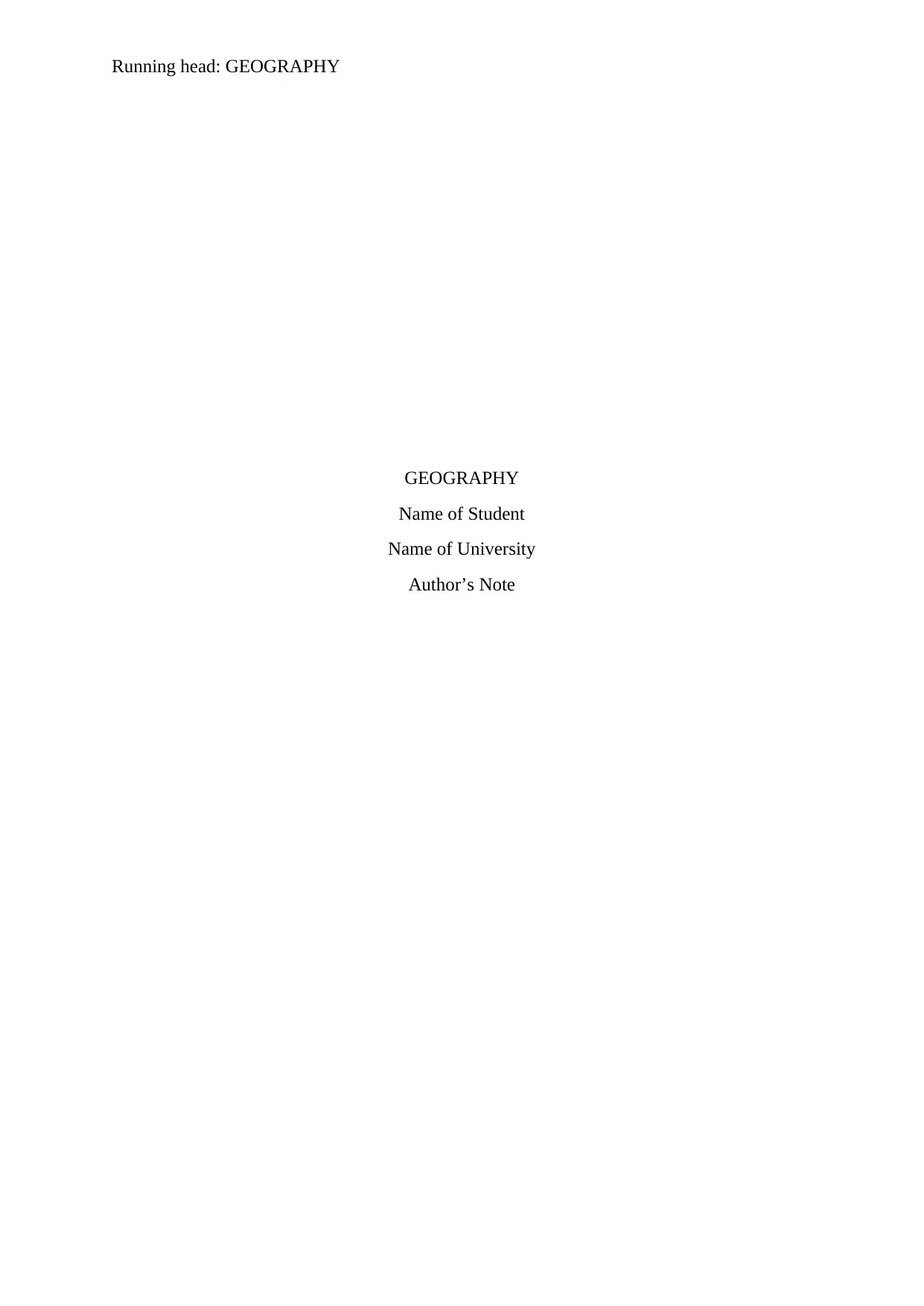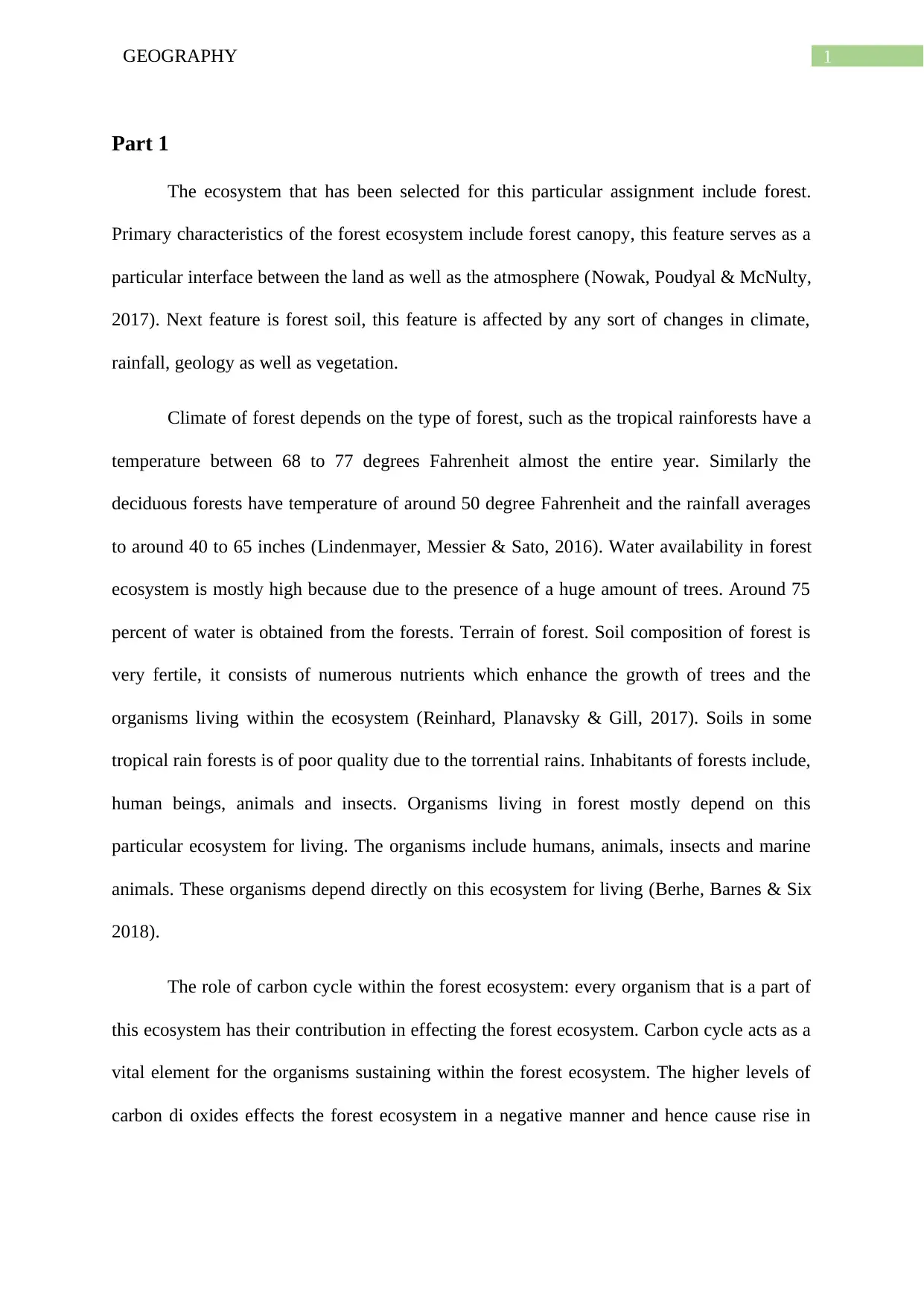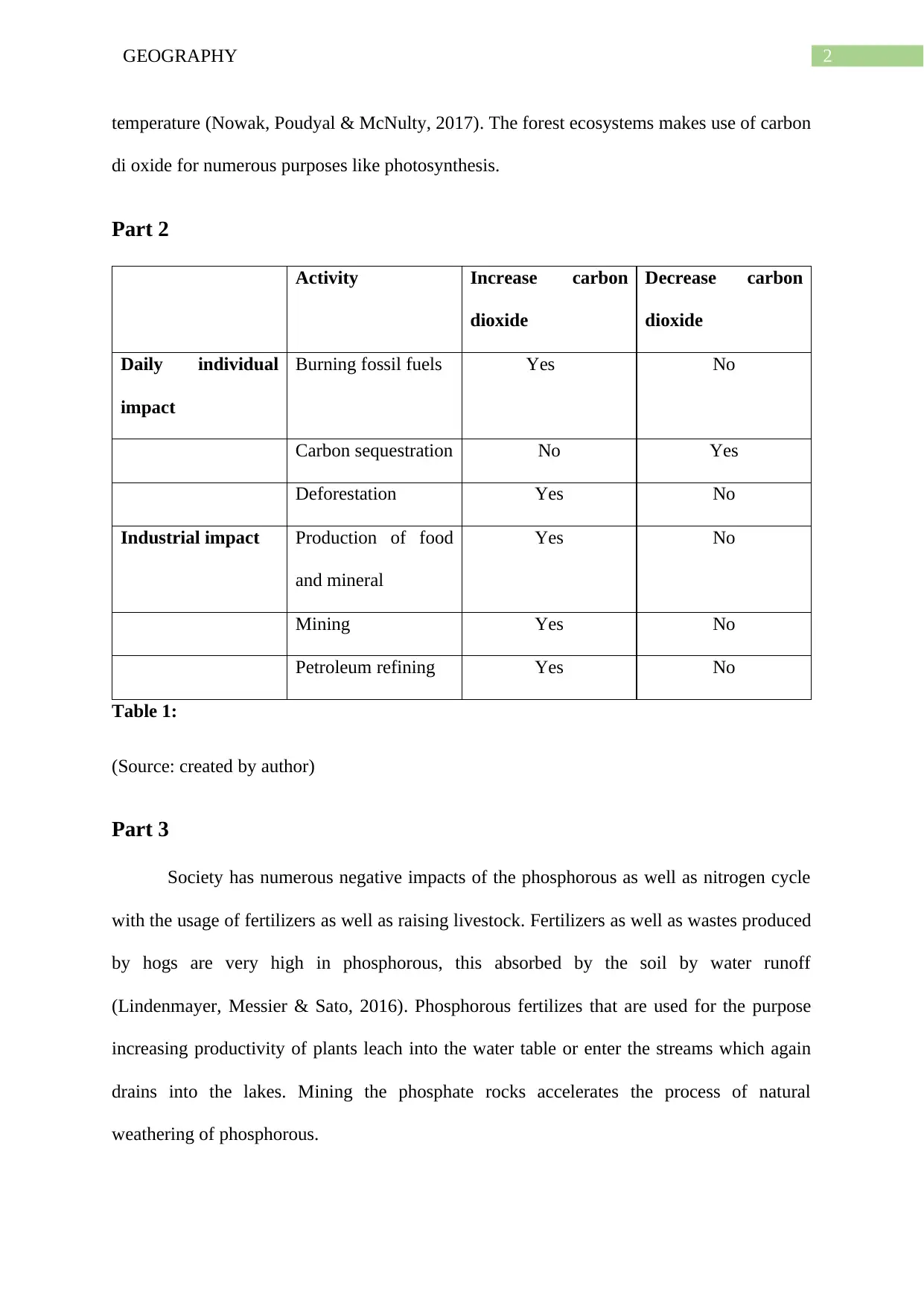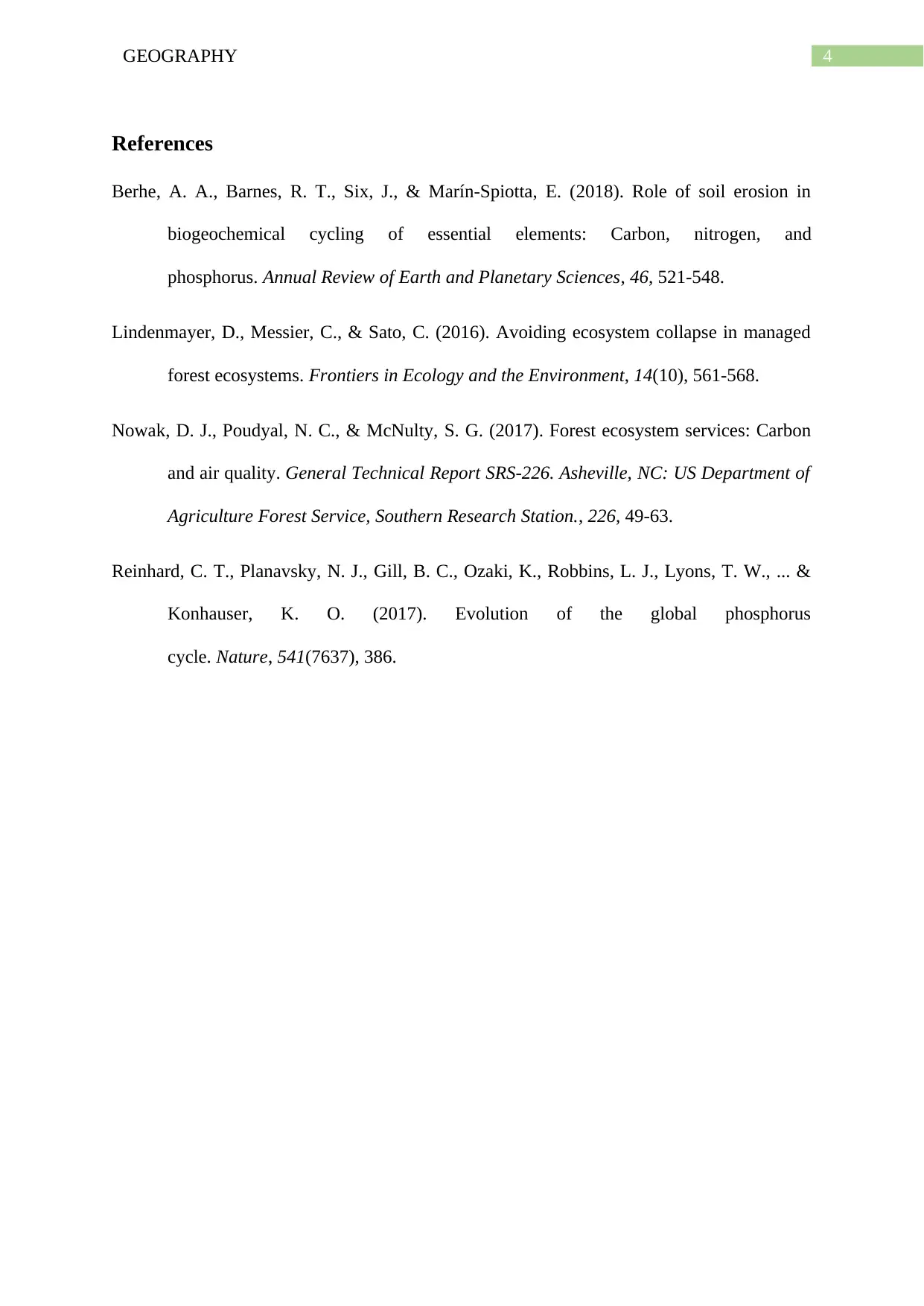Forest Ecosystem: Characteristics, Climate, and Role of Carbon Cycle
VerifiedAdded on 2022/12/20
|5
|808
|34
AI Summary
This assignment explores the characteristics of forest ecosystems, including forest canopy, soil, climate, water availability, and inhabitants. It also discusses the role of the carbon cycle in the forest ecosystem. Additionally, it examines the impact of human activities on carbon dioxide levels and the consequences of the phosphorus and nitrogen cycles.
Contribute Materials
Your contribution can guide someone’s learning journey. Share your
documents today.

Running head: GEOGRAPHY
GEOGRAPHY
Name of Student
Name of University
Author’s Note
GEOGRAPHY
Name of Student
Name of University
Author’s Note
Secure Best Marks with AI Grader
Need help grading? Try our AI Grader for instant feedback on your assignments.

1GEOGRAPHY
Part 1
The ecosystem that has been selected for this particular assignment include forest.
Primary characteristics of the forest ecosystem include forest canopy, this feature serves as a
particular interface between the land as well as the atmosphere (Nowak, Poudyal & McNulty,
2017). Next feature is forest soil, this feature is affected by any sort of changes in climate,
rainfall, geology as well as vegetation.
Climate of forest depends on the type of forest, such as the tropical rainforests have a
temperature between 68 to 77 degrees Fahrenheit almost the entire year. Similarly the
deciduous forests have temperature of around 50 degree Fahrenheit and the rainfall averages
to around 40 to 65 inches (Lindenmayer, Messier & Sato, 2016). Water availability in forest
ecosystem is mostly high because due to the presence of a huge amount of trees. Around 75
percent of water is obtained from the forests. Terrain of forest. Soil composition of forest is
very fertile, it consists of numerous nutrients which enhance the growth of trees and the
organisms living within the ecosystem (Reinhard, Planavsky & Gill, 2017). Soils in some
tropical rain forests is of poor quality due to the torrential rains. Inhabitants of forests include,
human beings, animals and insects. Organisms living in forest mostly depend on this
particular ecosystem for living. The organisms include humans, animals, insects and marine
animals. These organisms depend directly on this ecosystem for living (Berhe, Barnes & Six
2018).
The role of carbon cycle within the forest ecosystem: every organism that is a part of
this ecosystem has their contribution in effecting the forest ecosystem. Carbon cycle acts as a
vital element for the organisms sustaining within the forest ecosystem. The higher levels of
carbon di oxides effects the forest ecosystem in a negative manner and hence cause rise in
Part 1
The ecosystem that has been selected for this particular assignment include forest.
Primary characteristics of the forest ecosystem include forest canopy, this feature serves as a
particular interface between the land as well as the atmosphere (Nowak, Poudyal & McNulty,
2017). Next feature is forest soil, this feature is affected by any sort of changes in climate,
rainfall, geology as well as vegetation.
Climate of forest depends on the type of forest, such as the tropical rainforests have a
temperature between 68 to 77 degrees Fahrenheit almost the entire year. Similarly the
deciduous forests have temperature of around 50 degree Fahrenheit and the rainfall averages
to around 40 to 65 inches (Lindenmayer, Messier & Sato, 2016). Water availability in forest
ecosystem is mostly high because due to the presence of a huge amount of trees. Around 75
percent of water is obtained from the forests. Terrain of forest. Soil composition of forest is
very fertile, it consists of numerous nutrients which enhance the growth of trees and the
organisms living within the ecosystem (Reinhard, Planavsky & Gill, 2017). Soils in some
tropical rain forests is of poor quality due to the torrential rains. Inhabitants of forests include,
human beings, animals and insects. Organisms living in forest mostly depend on this
particular ecosystem for living. The organisms include humans, animals, insects and marine
animals. These organisms depend directly on this ecosystem for living (Berhe, Barnes & Six
2018).
The role of carbon cycle within the forest ecosystem: every organism that is a part of
this ecosystem has their contribution in effecting the forest ecosystem. Carbon cycle acts as a
vital element for the organisms sustaining within the forest ecosystem. The higher levels of
carbon di oxides effects the forest ecosystem in a negative manner and hence cause rise in

2GEOGRAPHY
temperature (Nowak, Poudyal & McNulty, 2017). The forest ecosystems makes use of carbon
di oxide for numerous purposes like photosynthesis.
Part 2
Activity Increase carbon
dioxide
Decrease carbon
dioxide
Daily individual
impact
Burning fossil fuels Yes No
Carbon sequestration No Yes
Deforestation Yes No
Industrial impact Production of food
and mineral
Yes No
Mining Yes No
Petroleum refining Yes No
Table 1:
(Source: created by author)
Part 3
Society has numerous negative impacts of the phosphorous as well as nitrogen cycle
with the usage of fertilizers as well as raising livestock. Fertilizers as well as wastes produced
by hogs are very high in phosphorous, this absorbed by the soil by water runoff
(Lindenmayer, Messier & Sato, 2016). Phosphorous fertilizes that are used for the purpose
increasing productivity of plants leach into the water table or enter the streams which again
drains into the lakes. Mining the phosphate rocks accelerates the process of natural
weathering of phosphorous.
temperature (Nowak, Poudyal & McNulty, 2017). The forest ecosystems makes use of carbon
di oxide for numerous purposes like photosynthesis.
Part 2
Activity Increase carbon
dioxide
Decrease carbon
dioxide
Daily individual
impact
Burning fossil fuels Yes No
Carbon sequestration No Yes
Deforestation Yes No
Industrial impact Production of food
and mineral
Yes No
Mining Yes No
Petroleum refining Yes No
Table 1:
(Source: created by author)
Part 3
Society has numerous negative impacts of the phosphorous as well as nitrogen cycle
with the usage of fertilizers as well as raising livestock. Fertilizers as well as wastes produced
by hogs are very high in phosphorous, this absorbed by the soil by water runoff
(Lindenmayer, Messier & Sato, 2016). Phosphorous fertilizes that are used for the purpose
increasing productivity of plants leach into the water table or enter the streams which again
drains into the lakes. Mining the phosphate rocks accelerates the process of natural
weathering of phosphorous.

3GEOGRAPHY
The consequences of human intrusion include damage caused to the marine life due to
drainage of phosphorous present in fertilizers (Berhe, Barnes &Six, 2018). The availability of
phosphorus and nitrogen had reduced to great extent.
Two examples of activities include usage of fertilizers to great extent and mining
large amount of phosphate rocks for making fertilizers that are commercially inorganic as
well as detergents.
The consequences of human intrusion include damage caused to the marine life due to
drainage of phosphorous present in fertilizers (Berhe, Barnes &Six, 2018). The availability of
phosphorus and nitrogen had reduced to great extent.
Two examples of activities include usage of fertilizers to great extent and mining
large amount of phosphate rocks for making fertilizers that are commercially inorganic as
well as detergents.
Secure Best Marks with AI Grader
Need help grading? Try our AI Grader for instant feedback on your assignments.

4GEOGRAPHY
References
Berhe, A. A., Barnes, R. T., Six, J., & Marín-Spiotta, E. (2018). Role of soil erosion in
biogeochemical cycling of essential elements: Carbon, nitrogen, and
phosphorus. Annual Review of Earth and Planetary Sciences, 46, 521-548.
Lindenmayer, D., Messier, C., & Sato, C. (2016). Avoiding ecosystem collapse in managed
forest ecosystems. Frontiers in Ecology and the Environment, 14(10), 561-568.
Nowak, D. J., Poudyal, N. C., & McNulty, S. G. (2017). Forest ecosystem services: Carbon
and air quality. General Technical Report SRS-226. Asheville, NC: US Department of
Agriculture Forest Service, Southern Research Station., 226, 49-63.
Reinhard, C. T., Planavsky, N. J., Gill, B. C., Ozaki, K., Robbins, L. J., Lyons, T. W., ... &
Konhauser, K. O. (2017). Evolution of the global phosphorus
cycle. Nature, 541(7637), 386.
References
Berhe, A. A., Barnes, R. T., Six, J., & Marín-Spiotta, E. (2018). Role of soil erosion in
biogeochemical cycling of essential elements: Carbon, nitrogen, and
phosphorus. Annual Review of Earth and Planetary Sciences, 46, 521-548.
Lindenmayer, D., Messier, C., & Sato, C. (2016). Avoiding ecosystem collapse in managed
forest ecosystems. Frontiers in Ecology and the Environment, 14(10), 561-568.
Nowak, D. J., Poudyal, N. C., & McNulty, S. G. (2017). Forest ecosystem services: Carbon
and air quality. General Technical Report SRS-226. Asheville, NC: US Department of
Agriculture Forest Service, Southern Research Station., 226, 49-63.
Reinhard, C. T., Planavsky, N. J., Gill, B. C., Ozaki, K., Robbins, L. J., Lyons, T. W., ... &
Konhauser, K. O. (2017). Evolution of the global phosphorus
cycle. Nature, 541(7637), 386.
1 out of 5
Your All-in-One AI-Powered Toolkit for Academic Success.
+13062052269
info@desklib.com
Available 24*7 on WhatsApp / Email
![[object Object]](/_next/static/media/star-bottom.7253800d.svg)
Unlock your academic potential
© 2024 | Zucol Services PVT LTD | All rights reserved.